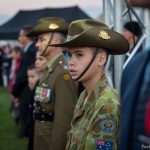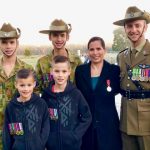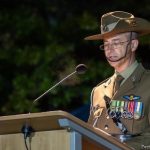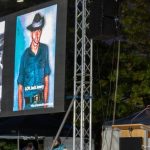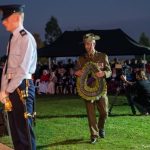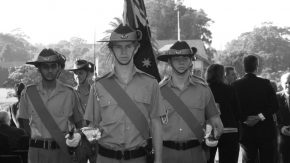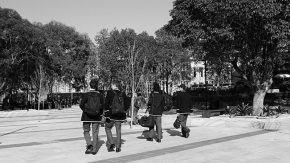2019 ANZAC Day
Major Lachlan Slatyer (ON 1986) was invited to deliver the ANZAC address at the Camden Dawn Service on ANZAC day this year where a record crowd of over 15,000 people attended making it the largest metropolitan ANZAC dawn service.
Lachlan spoke of the ANZAC spirit that Charles Bean identified in his book ANZAC to Amiens and reflected on the more modern terms that our current generation would use. He then took the crowd on a journey back to the Vietnam War and a battle that occurred on the 18th of August 1966, three years before he was born.
In 1966, the Australian Government committed more Australian troops in Vietnam. With the build-up of Australian Forces, the Viet Cong and North Vietnamese Army were determined to inflict a major defeat on the Australians as early as possible.
Though Australian intelligence picked up radio traffic suggesting a large enemy force was moving closer the Australian Base at Nui Dat, no signs of enemy had been detected until the early morning on 17 August 1966 when the Base was attacked by the Viet Cong using recoilless rifles and mortars injuring 24 Australian Soldiers.
On the 18th of August, Delta Company, 6th Royal Australian Regiment was ordered to follow some tracks that lead into the Long Tan rubber plantation. 11 Platoon contacted a small group of enemy shortly after entering the plantation causing the enemy to flee. The Australian soldiers were approved to chase the enemy which they did. A few minutes later, the Australian’s were engaged by heavy enemy machine guns killing four Australian soldiers and wounding a further two. What would follow would be an epic battle between 108 Australian and New Zealand soldiers and between 1,500 and 2,000 Viet Cong and North Vietnamese Army.
During the battle a large monsoonal rain storm caused major issues to those on the ground as well as the fighter jets that could drop their bombs and the two Australian Iroquois helicopters who struggled to fly a vital ammunition resupply to the soldiers as they were just about out of ammunition. In addition, the 24 artillery guns that provide an almost impenetrable wall between the Australian’s and the enemy was also hampered by the monsoonal storm as dangerous fumes built up around each gun.
When the Armed Personnel Carriers arrived some three hours after the first shots for fired, the enemy withdrew. On the battlefield, 18 Australian soldiers lay dead and another 24 wounded. The official Australian record stated 245 enemy bodies were found, though it is estimated the total body count was significantly more. It was also estimated that over 500 enemy soldiers were wounded; though all these figures are contested by North Vietnam.
Whilst the battle only lasted a few hours, D Company was awarded the United States Presidential Unit Citation and in 2011, the Australian Unit Citation for Gallantry. In addition, there were a total of twenty-five gallantry, service and conduct medals awarded as a result of the three-and-a-half-hour battle; a large number of medals for a relatively short, but intense battle.
In simple terms, the Australians should not have survived as they were outnumbered somewhere between 14 and 18 enemy soldiers to each soldier in Delta Company. They survived due to a number of factors. First the use of artillery support from the Australian, New Zealand and US Army batteries who fired in excess of 3,500 rounds which equated to over 16 artillery rounds a minute. The artillery was dropped as close as 50 metres in front of the Australian soldiers. Secondly, the Royal Australian Air Force helicopters who flew atrocious weather, over loaded to get the ammunition resupply to the soldiers who were nearly out of ammunition. Lastly the men on the ground were triumph as they possessed the same traits of courage, initiative, loyalty, mateship and a stubbiness to never accept defeat.
The Battle of Long Tan is one of many important battles that occurred in the Vietnam War, but little is known about it by the majority of Australian’s as the war became unpopular with the Australian population.
In closing, Lachlan reflected on how many of the current generation of returned service men and women viewed ANZAC day and he asked the large crowd to look around themselves in the light of the day and see the many service personnel wearing their medals and he asked them to please take the time to give the service personnel a smile and may be even say “thank you” for their service to our country.
The crowd was left emotional, particularly the Vietnam Veterans, as well as many who were completely unaware of the events that truly reflected the spirit of the ANZAC soldier occurred in a plantation in Vietnam in 1966.
Lachlan was supported by his wife, Allison who was a Nursing Officer in the Army and his sons, including Ashton Slatyer (Year 9).



